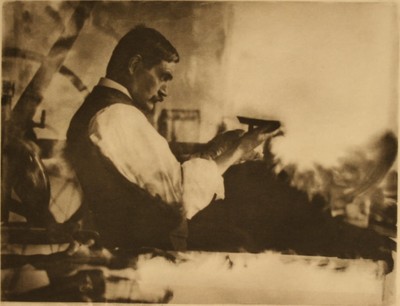Etching is an intaglio printmaking technique that uses acid to incise an image into a metal plate.
How do you make an etching? An etching metal plate is first covered with a layer of acid-resistant varnish or wax, known as the etching ground. The artist then uses an etching needle to scratch through the ground, revealing the bare plate. When the design is completed the plate is immersed in acid, which eats away at the areas of exposed metal to create incised lines. The remaining ground is removed, and the plate is covered in ink, which fills the recessed marks. The excess ink is then wiped from the surface of the plate. Finally, the inked plate is covered with a damp piece of paper and run through a press in order to create a finished print.
Glossary of Related Terms
Intaglio – A category of printmaking techniques that transfers ink from incised marks on a plate rather than from its surface. Intaglio techniques include etching, engraving, aquatint, and drypoint.
Aquatint – A technique that creates printed tonal areas that resemble watercolor or ink wash. Fine particles of acid-resistant rosin are deposited on a metal plate and adhered to the surface with heat. The plate is immersed in acid, which eats away at the metal, creating recesses around each particle. Once the rosin is removed, the plate is covered in ink, which collects in the small recessed areas created by the acid. The amount of rosin on the plate and the length of time the plate remains in the acid bath determine the tones in the printed impression.
Drypoint – A technique in which marks are cut directly into a metal plate with a sharp tool, without the use of ground or acid. When the surface of the plate is scratched with a tool, ridges of metal are displaced along the sides of the line. These raised parts, called the burr, hold ink when the plate is printed and produced the characteristic velvety drypoint lines. The burr wears down quickly due to the pressure of the printing process, meaning that only a limited number of high quality impressions can be made from a plate that includes drypoint.
Impression – A individual print pulled from an inked printing plate.
State – Any stage in the development of a print at which impressions are made. A change of state occurs whenever the plate is modified, either by adding new marks or by rubbing or buffing out previously etched lines.
Edition – A set of impressions produced from a single printing plate.


